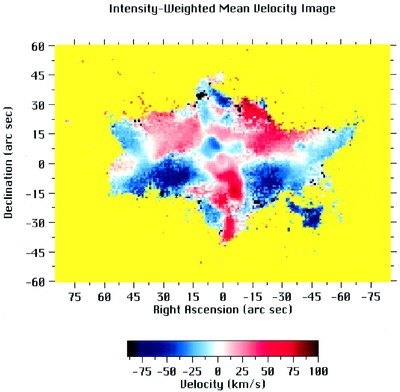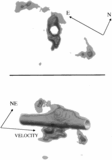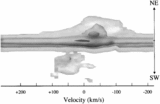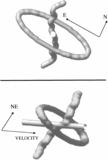Image Details

Caption: Fig. 2.
[N II] image of R Aqr showing how the intensity‐weighted mean radial velocity at each pixel varies across the nebula. The color wedge at the bottom of the image ranges from −90 km s−1 (blueshift) to +100 km s−1 (redshift). The approaching blue northeast jet and the receding red southwest jet combine to give the characteristic ﹩\textsf{S}﹩ shape of a precessing jet. Since the upper portion of the expanding hourglass is tipped toward the observer, we are looking into the northern bowl of the truncated hourglass. Therefore, the upper portion of the prominent hourglass waist and bowl backside, which dominates the local emission, is moving away from the observer and therefore appears red. In the southern view we are seeing the outside of the bowl of the truncated expanding hourglass; thus, the lower portion of the expanding hourglass waist and outside of the bowl is moving toward the observer, dominates the local emission, and appears blue. The extremities of this figure are further complicated by the edge‐brightened effects of the hourglass above and below thewaist. Most notably, the extension of red below the waist on the eastern edge is the edge‐brightened far side of the lower hourglass expanding away from theobserver; similarly, the blue extension above the waist on the eastern edge is the edge‐brightened near side of the upper hourglass expanding towardthe observer. This effect is not as prominent on the western edge, suggesting that there is less hourglass wall material, particularly to the south. In any case, the net effect of these complications and the heavily stretched color wedge gives the false impression of two arcs from two displaced ellipsoids which do not have a common origin, and a similar effect is noticeablein the movie (H. Lehto 1999, private communication).
Copyright and Terms & Conditions
© 1999. The American Astronomical Society. All rights reserved. Printed in U.S.A.







